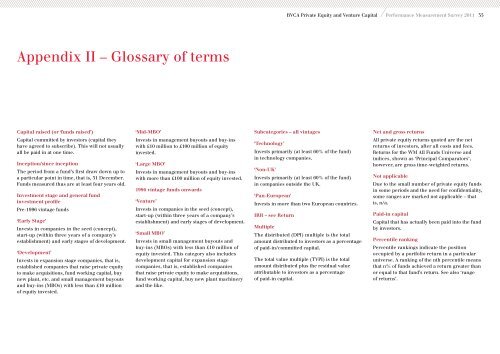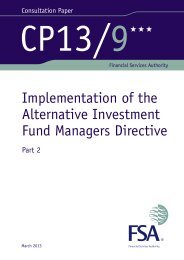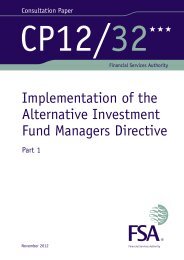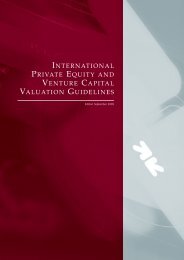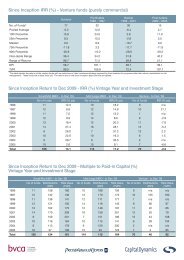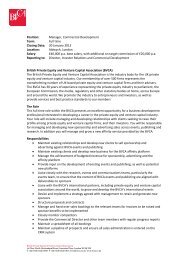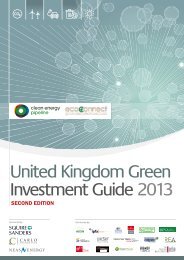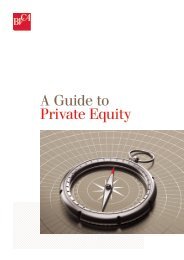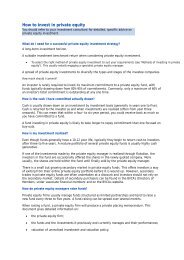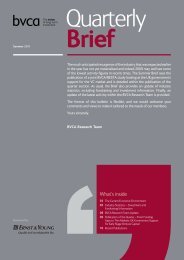BVCA Private Equity and Venture Capital ... - BVCA admin
BVCA Private Equity and Venture Capital ... - BVCA admin
BVCA Private Equity and Venture Capital ... - BVCA admin
Create successful ePaper yourself
Turn your PDF publications into a flip-book with our unique Google optimized e-Paper software.
Appendix II – Glossary of terms<br />
<strong>Capital</strong> raised (or ‘funds raised’)<br />
<strong>Capital</strong> committed by investors (capital they<br />
have agreed to subscribe). This will not usually<br />
all be paid in at one time.<br />
Inception/since inception<br />
The period from a fund’s first draw down up to<br />
a particular point in time, that is, 31 December.<br />
Funds measured thus are at least four years old.<br />
Investment stage <strong>and</strong> general fund<br />
investment profile<br />
Pre-1996 vintage funds<br />
‘Early Stage’<br />
Invests in companies in the seed (concept),<br />
start-up (within three years of a company’s<br />
establishment) <strong>and</strong> early stages of development.<br />
‘Development’<br />
Invests in expansion stage companies, that is,<br />
established companies that raise private equity<br />
to make acquisitions, fund working capital, buy<br />
new plant, etc. <strong>and</strong> small management buyouts<br />
<strong>and</strong> buy-ins (MBOs) with less than £10 million<br />
of equity invested.<br />
‘Mid-MBO’<br />
Invests in management buyouts <strong>and</strong> buy-ins<br />
with £10 million to £100 million of equity<br />
invested.<br />
‘Large MBO’<br />
Invests in management buyouts <strong>and</strong> buy-ins<br />
with more than £100 million of equity invested.<br />
1996 vintage funds onwards<br />
‘<strong>Venture</strong>’<br />
Invests in companies in the seed (concept),<br />
start-up (within three years of a company’s<br />
establishment) <strong>and</strong> early stages of development.<br />
‘Small MBO’<br />
Invests in small management buyouts <strong>and</strong><br />
buy-ins (MBOs) with less than £10 million of<br />
equity invested. This category also includes<br />
development capital for expansion stage<br />
companies, that is, established companies<br />
that raise private equity to make acquisitions,<br />
fund working capital, buy new plant machinery<br />
<strong>and</strong> the like.<br />
<strong>BVCA</strong> <strong>Private</strong> <strong>Equity</strong> <strong>and</strong> <strong>Venture</strong> <strong>Capital</strong> Performance Measurement Survey 2011 35<br />
Subcategories – all vintages<br />
‘Technology’<br />
Invests primarily (at least 60% of the fund)<br />
in technology companies.<br />
‘Non-UK’<br />
Invests primarily (at least 60% of the fund)<br />
in companies outside the UK.<br />
‘Pan-European’<br />
Invests in more than two European countries.<br />
IRR – see Return<br />
Multiple<br />
The distributed (DPI) multiple is the total<br />
amount distributed to investors as a percentage<br />
of paid-in/committed capital.<br />
The total value multiple (TVPI) is the total<br />
amount distributed plus the residual value<br />
attributable to investors as a percentage<br />
of paid-in capital.<br />
Net <strong>and</strong> gross returns<br />
All private equity returns quoted are the net<br />
returns of investors, after all costs <strong>and</strong> fees.<br />
Returns for the WM All Funds Universe <strong>and</strong><br />
indices, shown as ‘Principal Comparators’,<br />
however, are gross time-weighted returns.<br />
Not applicable<br />
Due to the small number of private equity funds<br />
in some periods <strong>and</strong> the need for confidentiality,<br />
some ranges are marked not applicable – that<br />
is, n/a.<br />
Paid-in capital<br />
<strong>Capital</strong> that has actually been paid into the fund<br />
by investors.<br />
Percentile ranking<br />
Percentile rankings indicate the position<br />
occupied by a portfolio return in a particular<br />
universe. A ranking of the nth percentile means<br />
that n% of funds achieved a return greater than<br />
or equal to that fund’s return. See also ‘range<br />
of returns’.


